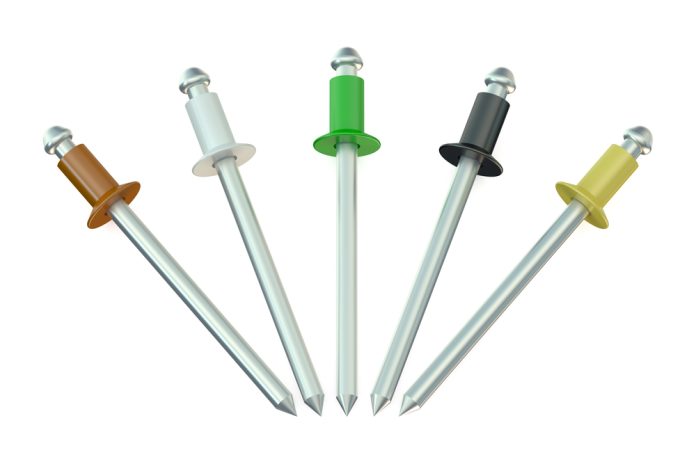Blind rivets (commonly referred to as “POP” rivets) are a two-part fastener. They are designed to permanently join two or more components together in a single action from one side of a workpiece.
They are manufactured from a variety of materials including steel, aluminum, and stainless steel. In their simplest form, the two parts typically consist of a hollow tube with a wide base (referred to as the Flange) which is assembled on to a headed wire (referred to as the mandrel). The two components are often manufactured from dissimilar materials to accommodate the rivets intended application.
There are an expansive number of applications and environments blind rivets utilize in. Therefore, a wide number of variations also exist in their functional and aesthetic design. This accommodates requirements such as water tightness, high loads, and fragile workpieces. Blind rivets work by creating a permanent connection using a positive clamping action. Therefore, they are the preferred fastener choice in applications where the workpieces to be joined are subject to vibration or movement, rendering thread forming screws or nuts and bolts unsuitable.
How Do They Work?
Blind rivets function by drawing the head of the mandrel into or through the rivet body using an installation tool. This deforms the body creating a bulge bigger than the hole size the rivet has been installed in. This results in the work pieces clamping tightly between the deformed end of the rivets body and the flange. Once fully set, the mandrel is designed to break off. This leaves only the flange of the rivet visible on the aesthetic side of the workpiece.
Before installing a blind rivet, a predetermined sized hole needs to be drilled through the workpieces that require joining. This is generally 0.1mm bigger than the body diameter of the rivet so a 4.8mm rivet requires a 4.9mm hole. Caution is necessary however as this is not a fixed rule. Depending on the application, variations of recommended hole sizes do exist. Always consult a reputable supplier about this as an incorrect selection of the required hole size results in reduced performance or failure.
Blind rivets have a defined working length commonly referred to as the “Grip range”. The grip range is always less than the overall length of the rivet and is essentially the complete thickness of material that the rivet has been designed to safely “clamp” together. The grip range is generally advised as a max and min value or measurement. If a blind rivet installs outside the parameters of its defined grip range, then it is likely to fail. For example, if a rivet with a max grip range of 10.0mm is installed in a workpiece measuring 11.0mm, it is at risk of “pulling through” the hole. This is due to the head not being allowed to deform the rivet appropriately and provide “pull through resistance”. If a rivet with a minimum grip range of 5.0mm is installed in a workpiece measuring 4.0mm then it is likely that the mandrel will break prematurely meaning the workpiece is not fully clamped and is “loose”.
Blind rivets defined technical values with regard to shear, tensile and pull-out performance. These values differ dramatically dependent upon the material the rivet is manufactured from, the rivet body dimensions, and the final substrate the rivet is to be installed in.
A reputable supplier has shear and tensile information as standard. However, pull-out values are subject to considerable variations about material types and thickness. They also are subject to bespoke testing. A reputable supplier has access to appropriate test equipment in order to assist with this.
Specifying the Correct Blind Rivet
With over 30 years’ experience supplying blind rivets into construction, façade, and industrial markets, Mainline Products assists designers, specifiers, and installers in choosing the correct blind rivet for your application. Their in-depth fastener knowledge, comprehensive product range, and unrivalled ability to color match fasteners to industry leading architectural cladding panels ensure you always have the right product on time every time.
Find a Home-Based Business to Start-Up >>> Hundreds of Business Listings.

















































